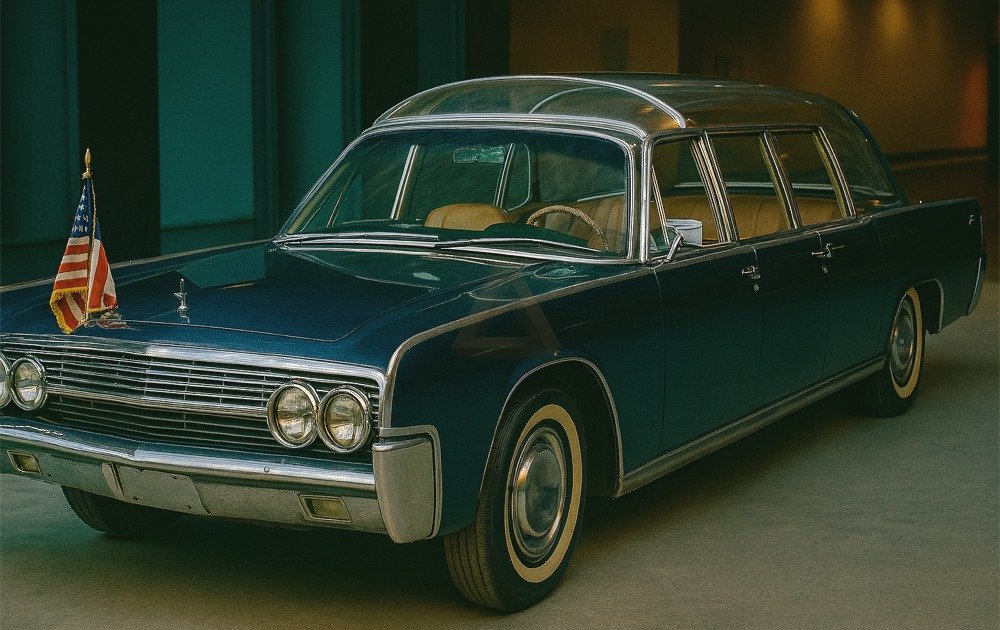
The presidential motorcade entered Dealey Plaza just after midday. President Kennedy sat exposed in the rear of a modified Lincoln Continental, waving to the crowd. The weather had cleared. The bubble top — designed for rain, not protection — had been removed. Within moments, gunfire broke the procession, and the president was mortally wounded.
In the decades since, one question has lingered in the margins of public memory: would the president have survived if the bubble top had been in place?
The answer is not simple. It threads myth, grief, and mechanical fact. It invites restraint.
The Car: SS-100-X
Kennedy’s limousine was a modified 1961 Lincoln Continental four-door convertible. Known as SS-100-X, it was customised by Hess & Eisenhardt at the request of the Secret Service. The base model cost $7,347. The modifications added another $200,000 to the cost — equivalent to over $2 million today.
Despite its ceremonial role, the car was not armoured. It had no bulletproof glass, no reinforced panels, no blast-resistant undercarriage. The bubble top — often mistaken for a security feature — was made of clear plastic and aluminium framing, and designed to shield the president from rain, not bullets.
According to Matt Anderson, curator of transportation at The Henry Ford Museum, the car was “a stock convertible with cosmetic upgrades — not a tank.”
The Decision to Remove the Top
Accounts vary on who ordered the bubble top removed that day. Some claim Kennedy preferred open cars for visibility. Others suggest the Secret Service made the call based on the weather. Jim Lehrer, then a reporter for the Dallas Times Herald, recalled asking an agent whether the top would stay on. The agent looked at the sky and said, “It’s clear. Lose the bubble top”.
This exchange has become part of assassination folklore. Lehrer later remarked, “I think Lee Harvey Oswald probably would not have taken the shots,” [had the bubble top remained.] But this belief, while emotionally resonant, is not supported by ballistic analysis.
While Lehrer’s comment threads grief and hindsight, it rests on a fragile assumption. Oswald could not have known in advance whether the president would be riding in an open vehicle. The motorcade’s configuration was subject to last-minute decisions, often dictated by weather and visibility. The bubble top was removable, and its use varied across stops.
Ballistic analysis further complicates the claim. Kennedy’s position in the rear seat left him exposed from above, behind, and to the right — angles that the bubble top, even if installed, would not have meaningfully obstructed. The canopy’s materials — lightweight plastic and aluminium — offered no ballistic resistance and would not have significantly deflected a high-velocity round.
This contradiction invites restraint. Lehrer’s remark reflects emotional logic, not mechanical fact.
Could the Bubble Top Have Helped?
The bubble top offered no ballistic protection. It was a removable canopy — lightweight, transparent, and vulnerable. The shots that killed Kennedy came from above and behind, fired from the sixth floor of the Texas School Book Depository. Kennedy’s position in the rear seat left him exposed from multiple angles — none meaningfully obstructed by the canopy’s materials.
Vincent Palamara, a recognised expert on Secret Service history, has debunked the notion that Kennedy ordered the top removed. His interviews with agents on duty that day confirm that the president made no such request.
Even if the top had been in place, it may have worsened visibility, deflected fragments, or created ricochet risks. But it was not designed to withstand gunfire. It was not a shield.
Why the Myth Persists
The bubble top myth endures because it offers a counterfactual — a way to imagine a different outcome. It threads grief with logic. It suggests that a simple decision might have changed history.
But myths often flatten complexity and overwrite ambiguity. In this case, the myth obscures the car’s actual vulnerabilities and the broader security failures of that day.
The Secret Service had limited protocols for motorcade protection. The Dallas route was published in advance. The car moved slowly through a confined space. There were no rooftop agents, no sniper detection systems, and no armoured plating.
The bubble top was not the problem. The perimeter was.
Aftermath and Upgrades
After Kennedy’s death, SS-100-X was sent back to Hess & Eisenhardt for retrofitting. The car was rebuilt with armour plating, bulletproof glass, and a permanent hardtop. It remained in service until 1977.
Presidential vehicles have since evolved into mobile fortresses. Barack Obama’s limousine — nicknamed “The Beast” — weighs over 15,000 pounds, with Kevlar-reinforced tires, oxygen tanks, and blood supplies.
Security protocols have changed too. Routes are classified. Speeds are faster. Rooftop agents and counter-sniper teams are standard. The perimeter holds more tightly than it did in 1963.
Public Reaction to SS-100-X
After its retirement in 1977, SS-100-X was transferred to The Henry Ford Museum in Dearborn, Michigan, where it remains on display. Visitors don’t linger for spectacle. They pause, sometimes silently, sometimes not. The car doesn’t explain itself. The bubble top sits off to the side, unremarkable unless you know what it meant. The signage is brief. It doesn’t dramatise. It doesn’t need to.
🔗 Think that was strange? There’s more. Explore our full Misconceptions Archive.
References
[1] Schieffer, B. (2013, November 15). A fateful decision that might have saved JFK’s life. CBS News. Retrieved October 2, 2025.
[2] Present-Echidna3875. (2023, December 14). What was the plan had JFK not decided to leave off the bubble top of the limo? Reddit. Retrieved October 2, 2025.
[3] Simkin, D. (n.d.). Primary Sources: Assassination of JFK. Spartacus Educational. Retrieved October 2, 2025.
[4] Palamara, V. (2013). Survivor’s Guilt: The Secret Service and the Failure to Protect the President. Trine Day.
[5] The Henry Ford Museum. (n.d.). SS-100-X Presidential Limousine. Retrieved October 2, 2025.
[6] Warren Commission. (1964). Report of the President’s Commission on the Assassination of President Kennedy. U.S. Government Printing Office.
